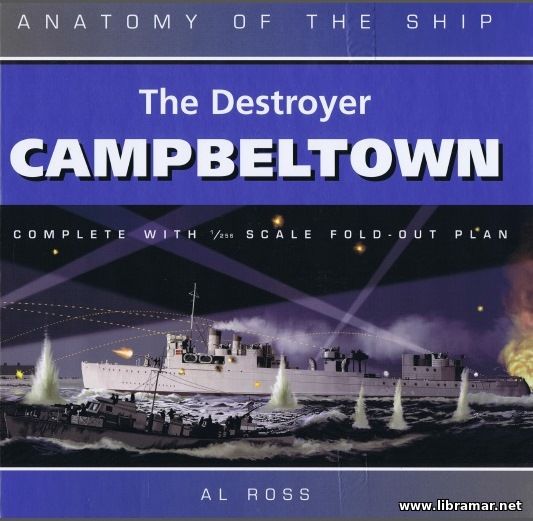 At 11:35 on 28 March 1942, at St Nazaire, France, the air was suddenly shattered by a thunderous explosion in the bows of an old destroyer lodged in the caisson of Normandie Loск. The forward half of the vessel, and a large number of unfortunate German soldiers inspecting her, were vapourized. The caisson was breached and what remained of the old destroyer was washed into the lock by the resulting inrush of water, effectively eliminating St Nazaire as a repair facility for Tirfntz. So ended the career of HMS Campbeltown (former USS Buchanan).
HMS Campbeltown was one of fifty obsolete flush-decked destroyer vessels which were transferred to the Royal Navy in exchange for leases on some British bases along the Atlantic seaboard. In May 1940, Prime Minister Churchill made his first request for destroyers to President Roosevelt. The Royal Navy's destroyer forces were essential to ensure the flow of materials to the island nation, but had suffered heavy losses in the first months of the World War II. Although the RN had 433 destroyers in service at the end of the World War I, it began the Second with only 184 available.
Despite the construction of 21 new destroyers during the first year of the new war, heavy losses, particularly those associated with the evacuations of Norway and Dunkirk, had brought this number down to 171. At first, Roosevelt was reluctant to countenance the transfer. There were several reasons for this...
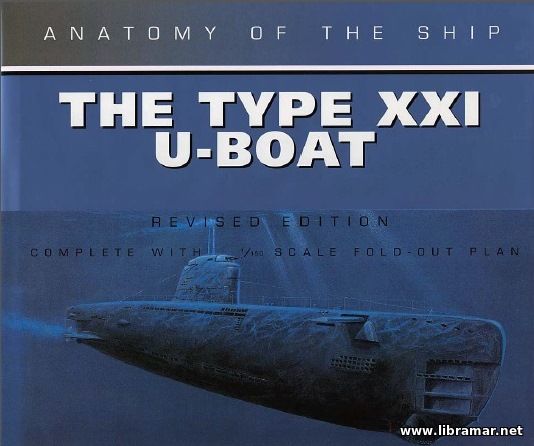 The publication we want to offer, is actually a popular German book which was first published in 1988 as "Ubootyp XXI" - it was later translated into English language. It contains much more supplementary images than any other release of the "Anatomy of the Ship" series does, more than a hundred, and includes ones taken of the boats being built and there are also many images taken afterwards. It is also very rich with the drawings of the boats - in facts, such drawings are re-drawn versions of the original shipyard plans issued for the new construction. In fact, the design of the submarines addressed in this publication was a very serious step in the whole history of the development of the underwater vehicles.
We could say that the vessels in questions served as the prototypes of the today's conventionally powered submarines. The first boats of this design were launched in 1944. Such submarines featured a number of innovations - for example, the schnorkel, allowing to run faster while being under the water, employing the diesel machines, and auto torpedo reload systems. Such novel design features helped these submarines in their service. The record of their brilliant service has also been provided in this publication.
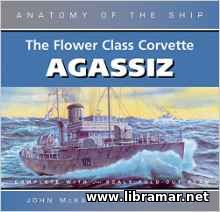 One more good book with so much of finest technical information and so many detailed drawings on the Agassiz. We would highly recommend this publication to people who are willing to get some better knowledge of the inside and outside of this type of vessel. In fact, this book is a complete technical work performed by the authors, John McKay and John Harland, on the Flower Class corvette.
The draftsmanship in this book is perfect, and every frame, beam and strength member is depicted in detail. This book will be invaluable for the naval history fans as well as for the modelers. Talking about Flower class vessels, they were legendary and typified the war against the submarines of Hitler's fleet. Featuring a novel whale catcher design, those ships were pressed into service as they could be built in large series and relatively fast - of course this is very important when there is a war.
The amateur naval architects will find this book very useful since it contains superbly detailed and informative diagrams supplemented with twenty-eight transverse sections of the hull made in 1:96 scale. The general naval architects will appreciate the deck plans and profile views, including cross-sections of anti-submarine weapons and other related ammunition.
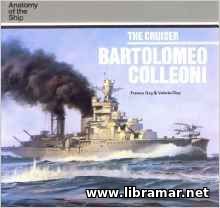 The origins of the light cruiser can be easily traced back to the so-called "protected cruisers" of the late nineteenth century. These designers of these vessels implemented a new feature - they came to the decision to eschewe side armour in favour of a protective deck at about waterline level over the machinery department as well as other spaces that were considered vital for the vessel, and although they tended to be smaller than the regular armoured cruisers, there were so many examples of very large protected cruisers, like the British Powerful and Terrible at fourteen thousand tons.
Simultaneously, much smaller cruisers were being built for use as fleet scouts and leaders of destroyer flotillas and at first these vessels had some deck protection but later classes adopted limited side armour as well. The readers will definitely see a true Italian touch in the design, construction and arrangement of Bartolomeo Colleoni - this can be felt even looking at the accommodation drawings. The remarkable research work performed by the duet of expert authors, Franco and Valerio Gay, is wonderful, taking into account the outstanding level of drawings and details provided even down to the sidearms...
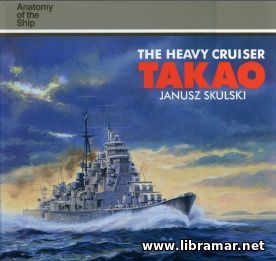 As it has been noted by one of the reviewers of the book, it contains enough information on the vessel to make a duplicate vessel. The book reflects the huge work performed by one of the foremost experts, Janusz Skulski, whose historical publications are popular and widely known for the first class drawings, provides valuable information about the Takao class of heavy cruisers that belonged to Japanese Navy Fleet.
The data contained in the book covers not only the design of the ships, but also hull structure and protection, machinery and armament, fire control arrangements, summary of service etc. One of the best resources in published in English language for the Japanese navy ships of the World War II. The text is supplemented with many photos and drawings such as general arrangement, superstructure, rig, armament, lines, body plan etc. We would think that this book is the must-have one for every naval historian; moreover, the amount of technical info and detailed drawings makes it very useful for those who like making models of the old ships - there will be no need for any other source of data when building a model of Takao since everything can be found in the single perfectly organized volume.
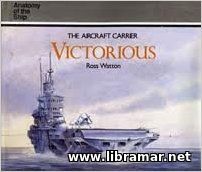 Prior to the order in 1917 for the first purpose-built aircraft carrier, HMS Hermes, the Royal Navy had relied upon a motley collection of mercantile and naval conversions on which to launch (and occasionally land) aircraft. None of these ships embodied all - if any - of the essential elements of a genuine aircraft carrier, but all contributed in some way to the eventual development of such a vessel. During this same period the role of the aircraft at sea was also undergoing a transformation.
Originally envisaged as a useful spotting device for relaying the fall of shot from a battleship's main armament, the aircraft was slowly gaining recognition as an effective striking force in its own right. The Washington Treaty of 1922 did much to stunt the development of new carriers by placing a limitation of 27,000 tons displacement per carrier, within a total tonnage of 135,000 tons for America and Britain and 81,000 tons for Japan. This limitation remained in force until the end of 1936. Each country was also permitted to convert two 33,000-ton capital ships into aircraft carriers.
This additional provision suited the Royal Navy, which had a recognised requirement for five carriers and was thus able to convert the large light cruisers Courageous and Glorious into carriers during the latter half of the 1920s, in a similar fashion to HMS Furious (originally converted in 1917 and more extensively reworked between 1921 and 1925). A special clause in the Treaty enabled the USA to convert her two battlecruisers Lexington and Saratoga, which finally displaced 38,500 tons, under the pretext of permitting modifications to existing capital ships in order to protect them from underwater and air attack.
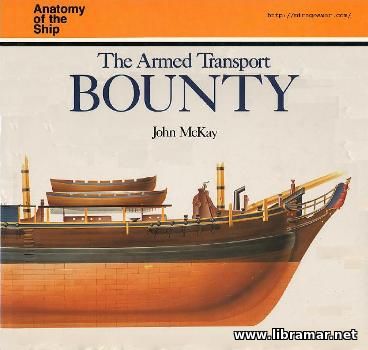 The Anatomy of the Ship book dedicated to the eternally famous armed transport Bounty. Centuries ago, in the year 1775, The Standing Committee of West India Planters & Merchants decided to introduce bread-fruit trees and mangosteen into the West India colonies as an inexpensive source of food for their plantation slaves.
An excellent prize was offered to anyone who successfully transported bread-fruits from the East to the West Indies, and, in 1777, a fund was set up to encourage people's interest in the subject adventurous and so interesting project. The book starts with the introductory chapter providing some historical background. Then, there is info on the hull construction, refit and decoration, steering gear and ground tackle, pumps, boats, crew and accommodation, masts and yards (with dimensions specified), sails, rigging, ordnance.
This chapter is followed by a number of nice close-up photos of the full size replicas of the HMS Bounty, and the next and last section of the publication contains and a truly huge collection of detailed technical drawings, including three-view drawings, and good construction plans. we do believe it is needless to say that the full and thorough description of the vessel is also provided to the reader.
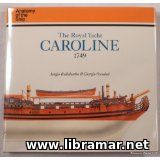 This book by Giorgio Osculati and Sergio Bellabarba was released to serve as a reference book for ship modelers. As it is already the established tradition for all of the Anatomy of the Ship series publications, it contains so much valuable technical and historical information about the Royal Yacht Caroline - it all makes the book extremely useful for that such enthusiasts.
The first, introductory part of this publication, provides us with some historical background and sheds some light on the development of the "career" of this remarkable vessel, her reconstruction, hull structure and fittings, decorative work, armament, spars and masts; particular attention has been paid by the author to sails arrangement, trestletrees, tops and caps, standing rigging, belaying, rigging dimensions, colour scheme, running rigging. There are many photographs in the book included to illustrate the text.
In addition to the images mentioned above, a number of detailed regular and three-view drawings addressing ship construction, lines, general arrangement, decoration and fittings, armament and boats, yards and masts, sails and rigging have been provided by the duet of authors in order to make the book even more useful and practical for model makers.
|







